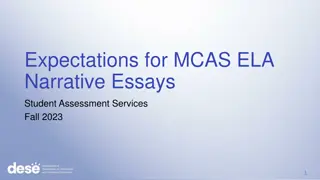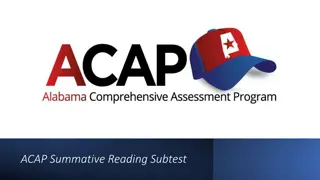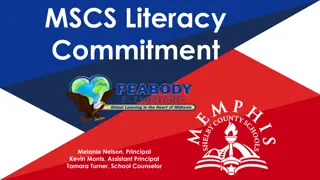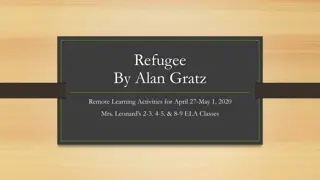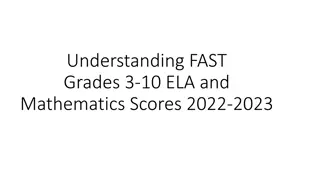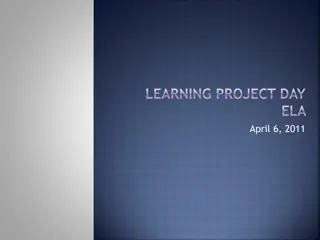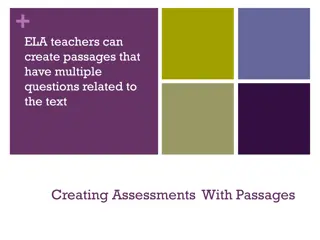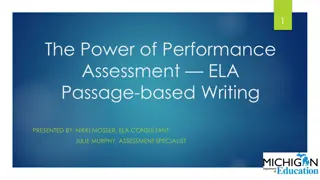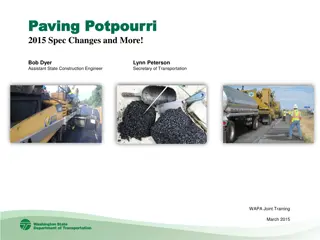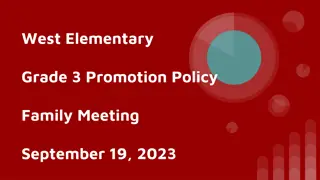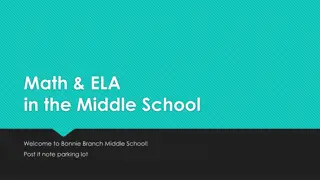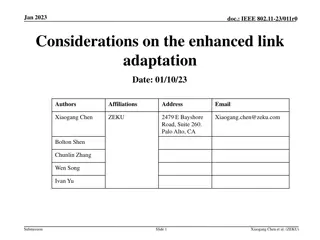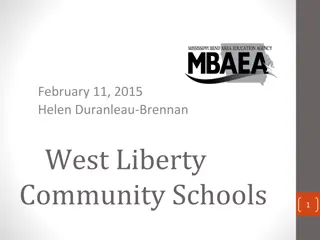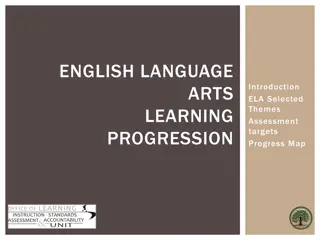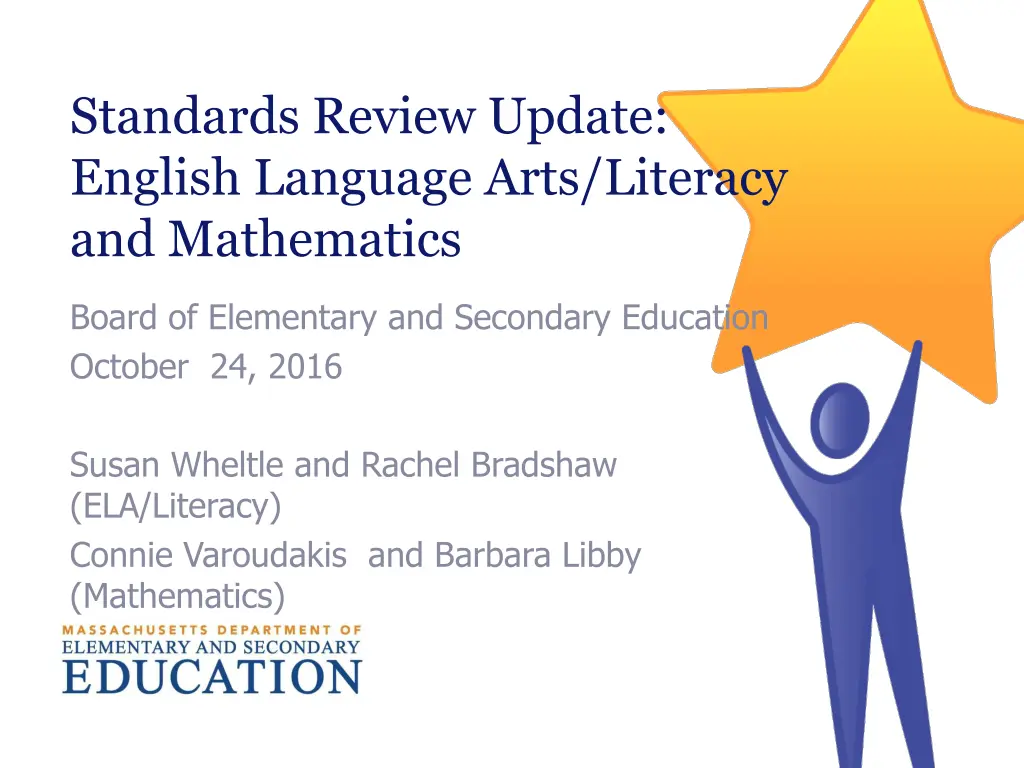
Massachusetts Standards Review Update: ELA/Literacy and Mathematics Board Meeting
Stay updated on the progress and proposed revisions for Massachusetts ELA/Literacy and Mathematics frameworks. The meeting aims to engage in discussions, clarify next steps, and respond to Board questions. Explore key topics such as complex texts, literary concepts, and course sequences. Reference materials provide detailed insights and recommendations for enhancing curriculum and assessment practices.
Download Presentation

Please find below an Image/Link to download the presentation.
The content on the website is provided AS IS for your information and personal use only. It may not be sold, licensed, or shared on other websites without obtaining consent from the author. If you encounter any issues during the download, it is possible that the publisher has removed the file from their server.
You are allowed to download the files provided on this website for personal or commercial use, subject to the condition that they are used lawfully. All files are the property of their respective owners.
The content on the website is provided AS IS for your information and personal use only. It may not be sold, licensed, or shared on other websites without obtaining consent from the author.
E N D
Presentation Transcript
Standards Review Update: English Language Arts/Literacy and Mathematics Board of Elementary and Secondary Education October 24, 2016 Susan Wheltle and Rachel Bradshaw (ELA/Literacy) Connie Varoudakis and Barbara Libby (Mathematics)
Massachusettss goal is to prepare all students for success after high school, by: Strengthening curriculum, instruction, & assessment Promoting educator development Turning around the lowest performing districts & schools Using technology and data to support teaching & learning Attending to the social/emotional/health needs of students & families 2 2 Massachusetts Department of Elementary and Secondary Education
Objectives for this meeting: Update the Board on the progress of the review of the 2011 Massachusetts Frameworks for English Language Arts and Literacy and Mathematics. Engage in discussion on the proposed revisions in ELA/Literacy and Mathematics. Respond to Board questions and clarify next steps in preparation for the November Board meeting. 3 Massachusetts Department of Elementary and Secondary Education
Agenda Framing comments, history & orientation ELA/Literacy: Key topics of interest: Reading closely and writing about complex texts; addressing literary concepts Examples of proposed revisions Discussion Mathematics: Key topics of interest: Offering of high school Algebra I Model Course in middle school and options for course sequences and pathways Examples of proposed revisions Discussion Massachusetts Department of Elementary and Secondary Education 4
Reference Materials Final Report: Massachusetts ELA/Literacy and Mathematics Curriculum Frameworks Review by Abt Associates Overview of Major Recommendations: Massachusetts Curriculum Frameworks for English Language Arts and Literacy Standards Review 2016 ELA/Literacy Detailed Proposed Revisions Overview of Major Recommendations: Massachusetts Curriculum Frameworks for Mathematics Standards Review 2016 Mathematics Detailed Proposed Revisions 2011 ELA/Literacy and Mathematics Frameworks 5 Massachusetts Department of Elementary and Secondary Education
Brief History: Standards in Massachusetts 1993 Education Reform Act: MA one of first states to implement standards-based reform; mandated development of content standards and a statewide assessment of those standards 1995: Board adopted the first Mathematics Framework; and the first ELA Framework in 1997 2000: Revised ELA/Literacy and Mathematics Framework adopted; Grade-level Supplements added in 2004 2010: Revised ELA/Literacy and Mathematics Frameworks adopted, incorporated the Common Core State Standards 6 2015 Board recommended new assessment and charged ESE with reviewing and revising Curriculum Frameworks Massachusetts Department of Elementary and Secondary Education
Current Work: Goal: Make recommendations to the Board to revise the standards, based on evidence from lessons learned during Massachusetts educators implementation of the standards over the past five years. 7 Massachusetts Department of Elementary and Secondary Education
Process: Three Phases Phase 1 (January-July 2016): Engaged stakeholders and gathered recommendations for revisions; Phase 2 (July-October 2016): Engaged content advisors and refined revisions; progress report to the Board; Phase 3 (November 2016-Spring 2017): Refine the proposed revisions; bring them to the Board for review and a vote to release for public comment (Nov); conduct public comment period, synthesize public comment; make final revisions and bring the final proposed standards to the Board for vote to adopt. 8 Massachusetts Department of Elementary and Secondary Education
Orientation to the Curriculum Frameworks: Vision statement Guiding principles for effective programs Orientation and structure Learning standards Supporting resources for educators and programs 9 Massachusetts Department of Elementary and Secondary Education
What is a Standard? Specifies what students should know, understand, and be able to do Demonstrated knowledge and skills Measurable 10 Massachusetts Department of Elementary and Secondary Education
English Language Arts and Literacy Major Recommendations for Revisions
The Structure of the 2011 ELA/Literacy Framework Anchor standards for College and Career Readiness, PK-12 Individual grade standards, PK-8; Grade bands for 9-10 and 11-12 5 Key Topics for Standards: 1. Reading Literary and Informational Texts and Foundations of Reading 2. Writing: argument, explanation, narrative and research 3. Speaking and Listening: discussion and presentation 4. Language: standard English conventions and vocabulary development 5. Literacy in History and Social Studies, Science, and Technical Subjects 12 Massachusetts Department of Elementary and Secondary Education
Topics of Major Recommendations Reading closely and writing about complex texts Addressing literary concepts Increasing coherence and focus, rigor, and clarity 13 Providing resources Massachusetts Department of Elementary and Secondary Education
1. Reading Closely and Writing about Complex Texts To increase coherence, make explicit cross- references among the standards for Reading, Writing, and Language To increase rigor, edit standards and provide examples of effective teaching practices To increase clarity, expand the glossary; use terms consistently, and include explanatory material on qualitative measures of text complexity 14 Massachusetts Department of Elementary and Secondary Education
1. Reading Closely and Writing about Complex Texts Coherence: Cross-references among standards (page 2 of Overview) 2011 Grade 6 Language standard 1: Demonstrate command of the conventions of standard English grammar and usage when writing or speaking Proposed Grade 6 standard: Demonstrate command of the conventions of standard English grammar and usage when writing or speaking; retain and further develop language skills learned in PK to grade 5. (See Writing standard 5 and Speaking and Listening standard 6 on strengthening writing and presentations by applying knowledge of language.) 15 Massachusetts Department of Elementary and Secondary Education
1. Reading Closely and Writing about Complex Texts Rigor: Edits to standards and curriculum units that integrate the standards for Reading, Writing, and Language (page 3) Proposed Grade 10 example: Students read Shakespeare s play, Richard II, pay close attention to recurring words and images that associate the king with the sun, brightness, height, and power; they write essays about such image clusters and their impact on the meaning of the play. 16 Massachusetts Department of Elementary and Secondary Education
1. Reading Closely and Writing about Complex Texts Rigor: Text Complexity (page 10) 2011 Grade 3 Reading Informational Text By the end of the year, read and comprehend informational texts, including history/social studies, science, and technical texts, at the high end of the grades 2-3 complexity band independently and proficiently. Proposed revision: Independently and proficiently read and comprehend informational texts, including history/social studies, science, and technical texts, of appropriate complexity for grade 3 or higher. 17 Massachusetts Department of Elementary and Secondary Education
1. Reading Closely and Writing about Complex Texts Clarity: Strengthen the Glossary, and add explanatory materials on text complexity (Pages 4 and 5) Define and use consistently academic vocabulary such as read closely and image and literary terms such as theme and metaphor. Identify qualitative dimensions of text complexity Meaning and Knowledge Demands Text Structure Language Features: vocabulary and syntax Connections between text and illustrations or graphics 18 Massachusetts Department of Elementary and Secondary Education
2. Addressing Literary Concepts (pages 6 and 7) In 2010, Massachusetts added 2 PK-12 standards for Reading Literature and Writing Their purpose was to augment the Common Core State Standards treatment of literary concepts In 2016, Massachusetts educators said these standards were difficult to implement because they were too genre specific and they restricted teachers choice of literary texts 19 Massachusetts Department of Elementary and Secondary Education
2. Addressing Literary Concepts Proposed revisions (pages 6 and 7) For greater coherence, delete the 2 MA standards and integrate their content into other Reading, Writing, Speaking and Listening, and Language standards The revisions streamline the standards for Reading Literature and Writing deepen the importance of conceptual knowledge of literature by applying it to speaking and listening as well as reading and writing 20 Massachusetts Department of Elementary and Secondary Education
2. Addressing Literary Concepts 2011 grade 8 Reading Literature standard MA.8.A: Identify and analyze the characteristics of irony and parody in literary works. Proposed grade 8 Reading Literature standard 4: Determine the meaning of words and phrases as they are used in a text, including figurative and connotative meanings; analyze the impact of specific word choices on meaning, tone, and mood, including the use of allusion and irony. (See Language standards 4-6 on applying knowledge of vocabulary to reading.) Proposed grade 8 Language standard 6a: Understand and use correctly literary and general academic terms to describe and analyze texts (e.g., terms used in previous grades, new terms such as allusion, analogy, comedy, irony, parody, tragedy). 21 Massachusetts Department of Elementary and Secondary Education
2. Addressing Literary Concepts 2011 grade 8 Writing standard MA.3.A: Write short narratives, poems, scripts, or personal reflections that demonstrate understanding of irony or parody. Proposed grade 8 Writing standard 3a: Demonstrate understanding of literary concepts such as mood, tone, point of view, personification, symbolism, and irony. Proposed grade 8 Writing standard 10: Write routinely in a variety of genres (e.g., poems, stories, scripts, reflections, essays) over extended time frames (time for research, reflection, and revision) and shorter time frames (a single sitting or a day or two) for a range of discipline-specific tasks, purposes, and audiences. 22 Massachusetts Department of Elementary and Secondary Education
Your Questions We welcome your comments and questions on the proposed revisions we have described and any of the further proposed revisions on pages 8 through 14 of the Overview document. 23 Massachusetts Department of Elementary and Secondary Education
Mathematics Major Recommendations for Revisions
Topics of Major Recommendations 1. Major Theme: Options for Course-Taking Sequences 2. Increase Coherence Focus Rigor Clarity 3. Other Revisions 25 Massachusetts Department of Elementary and Secondary Education
2011 MA Curriculum Framework for Mathematics Organization I. II. Guiding Principles for Mathematics Programs III. Standards for Mathematical Practice IV. Pre-K to 8 Grade-level content standards A. Grade-level Introductions highlighting critical areas B. Grade-level Overviews of the domains and clusters V. High School Standards: Conceptual Categories VI. High School Model Pathways (Traditional and Integrated) and Model Courses (Alg. I, Geom., Alg. II, Math I, Math II, Math II) VII.Appendices VIII.Sample of work consulted IX. Glossary, Illustrations, and tables Introduction 26 Massachusetts Department of Elementary and Secondary Education
Pre-K-8 Domains Progression (p. 1) PKK 1 2 3 4 5 6 7 8 Domains Counting and Cardinality Operations and Algebraic Thinking Number and Operations in Base Ten Number and Operations - Fractions Ratios and Proportional Relationships The Number System (Rational and Irrational) Expressions and Equations (Algebraic) Functions (Algebraic) Geometry 27 Measurement and Data Statistics and Probability Focus Coherence Clarity Rigor Massachusetts Department of Elementary and Secondary Education
2011 ESE Guidance Document Making Decisions about Course Sequences (p. 1) HS Model Algebra I in Grade 8 28
1. Options for Course-Taking Sequences: High School Pathways (p. 2) Rationale Recommendations Include the guidance document in the high school section of the framework Revise the course sequence graphic to include pathways to calculus and other advanced courses Need a pathway for students who are ready to take the HS Model Algebra I course in Gr. 8 Need for pathways to calculus for students who are ready to accelerate in high school Offer additional pathways for advanced courses tailored to students interests and plans (statistics, discrete mathematics, advanced functions and trig etc.) 29 Massachusetts Department of Elementary and Secondary Education
2. Increase Coherence: Example-Recognizing Patterns (p. 3) Recommendations Rationale Maintains the focus on numbers and operations and is foundational for algebraic thinking Connects to the Standards for Mathematical Practice Looking for and making use of structure and Look for and express regularity in repeated reasoning Added language to recognize and/or identify patterns in grades K-2, Example: Kindergarten.CC.1 Count to 100 by ones and tens. Recognize the one more and ten more patterns of counting. 30 Massachusetts Department of Elementary and Secondary Education
2. Increase Coherence: Consistent Language and Definitions (p. 5) Recommendations Keep the two know from memory standards. Add definitions to Framework for fluency, know from memory, standard algorithm, and algorithm Include significance of using strategies to develop number sense and fluency precedes knowing math facts from memory Rationale Students need to be able to quickly recall math facts in order to efficiently calculate and solve more complex calculations and problems as they advance in their mathematical studies 31 Massachusetts Department of Elementary and Secondary Education
2. Increase Coherence: Consistent Language and Definitions (pp. 3-4) Fluency: Fluency is knowing how a number can be composed and decomposed and using that information to be flexible and efficient in solving problems. The best way to develop fluency is to develop number sense and to work with numbers in different ways. (Parish., S. 2014. Number Talks: Helping Children Build Mental Math and Computational Strategies, Grades K 5, 2014, p. 159. Updated with Common Core Connections, Math Solutions.) Know from Memory: As students work on meaningful number activities they will commit facts to memory (recall and easily retrieve to use when needed) at the same time as understanding numbers and math. Students are expected to build understanding and then they are expected to know facts from memory. (Adapted from Jo Boaler, 2015, Fluency Without Fear. Youcubed.org) 32 Massachusetts Department of Elementary and Secondary Education
2. Increase Focus: Example-Rate (p. 6) Recommendations Add the word rate to grade 6 cluster heading of standards in the Ratio and Proportional Relationships domain Revised cluster heading: Understand ratio and rate concepts and use ratio and rate reasoning to solve problems Rationale Connecting Ratio and Rate is a critical focus in Grade 6 Using both ratio and rate reasoning to solve problems To develop strong proportional reasoning skills and provide a strong foundation for future work with algebraic expressions and equations in grade 7 and linear functions in grade 8 33 Massachusetts Department of Elementary and Secondary Education
Defining Rigor in the Math Framework Conceptual Procedural 34 Application Focus Coherence Clarity Rigor
2. Rigor: Example- 20 High School Plus (+) Standards (p. 7) Model Geometry (9 ) Model Algebra II (11) (5) N-VM (vectors and matrices) (2) N-CN (complex #s) (1) A-APR (the binomial theorem) (1) A-APR. (Closure property of rational expressions) (2) S-MD (using probability to make decisions) (3) G-SRT (Trig) (1) G-C4 (Construct a tangent to a circle from a point outside the circle) (1) G-GMD (informal argument Cavalieri s) Principle (2) S-CP (probability) (2) S-MD (probability) 35 Massachusetts Department of Elementary and Secondary Education
2. Maintain Rigor: Example-High School (+) Plus Standards (p. 7) Recommendations Retain the high school (+) Plus standards in the Model High School courses Rationale (+) standards are optional Equity: Inclusion provides differentiated learning opportunities for students who are ready for advanced content Retains coherence within the course by connecting content Prepares students for advanced coursework in which the standards are prerequisites 36 Massachusetts Department of Elementary and Secondary Education
2. Increase Clarity: Example-Visual Model Existing Grade 4 number and operations with fractions standard:4.NF.1 Explain why a fraction a/b is equivalent to a fraction (n a)/(n b) by using visual fraction models, with attention to how the numbers and sizes of the parts differ even though the two fractions themselves are the same size. Use this principle to recognize and generate equivalent fractions. Added a visual model example 2/3 of the whole region is shaded 8/12 of the whole region is shaded 37 2/3 = (2 x 4)/(3 x 4) = 8/12 Rationale: The edit provides clarification for types of visual models that can be used to explain fraction equivalency.
3. Revisions to Other Sections (p. 9) Recommendation Standards for Mathematical Practice descriptions by narrower grade spans Update Appendices Glossary Hyperlink standards to examples, glossary terms, Model Curriculum Units, etc. Rationale The narrower grade span descriptions make them more relevant, understandable, and usable for teachers to engage students in the math content Updated appendices make the Framework more user-friendly 38 Massachusetts Department of Elementary and Secondary Education
Your Questions We welcome your comments and questions on the proposed revisions we have described and any of the further proposed revisions in the Overview document. 39 Massachusetts Department of Elementary and Secondary Education

